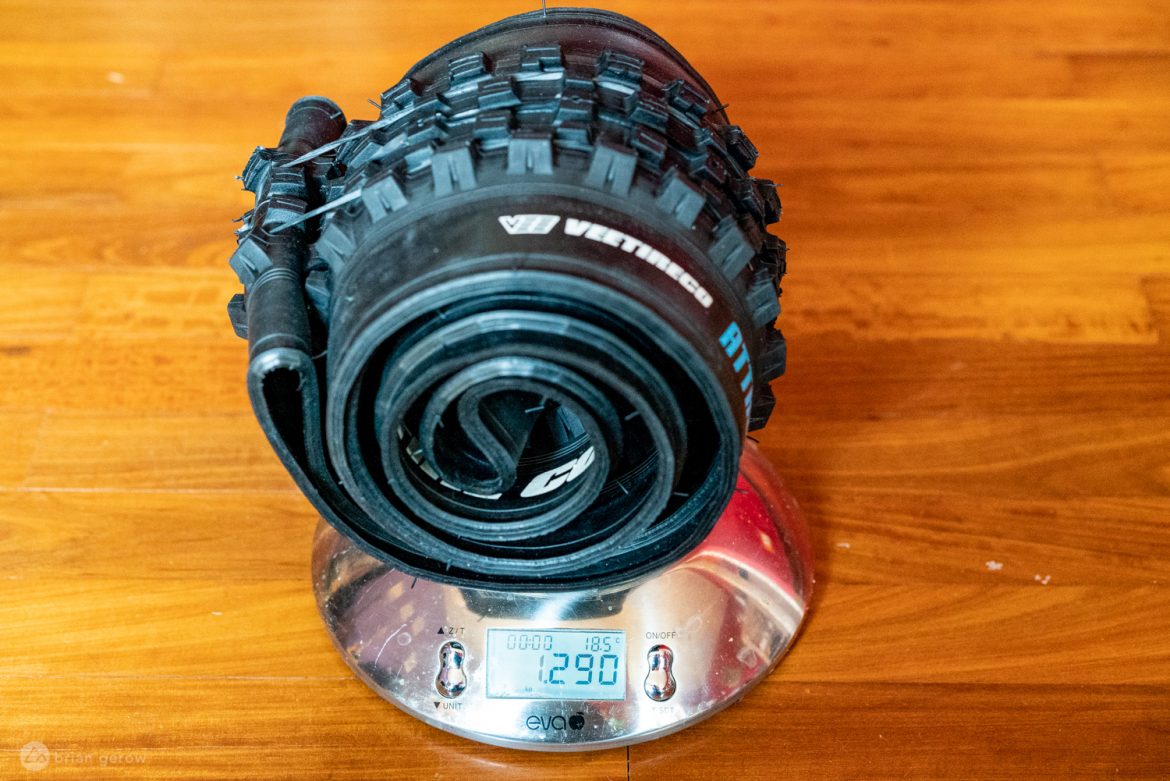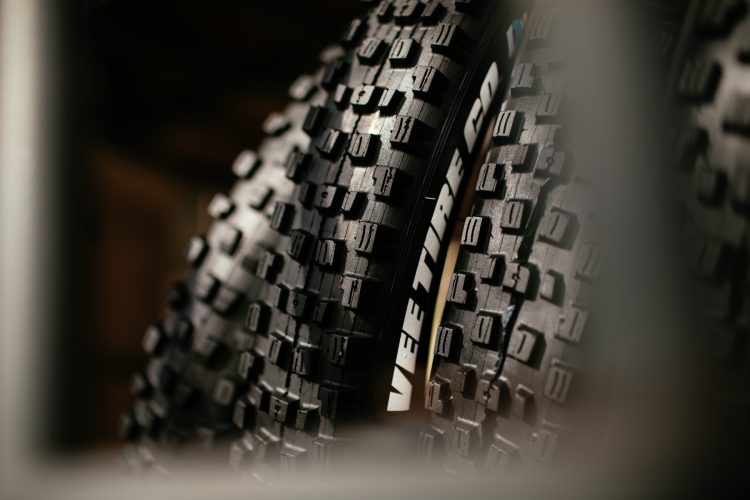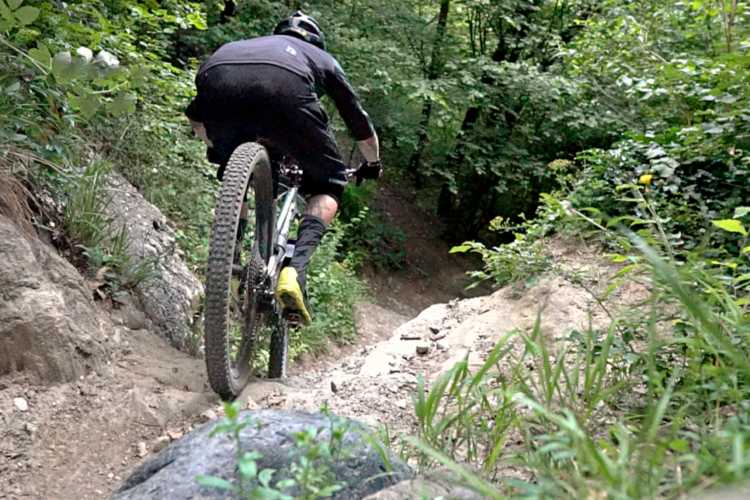
Two of our writers recently tested the new Vee Attack HPL gravity tread in both casings options, over varied terrain, on different continents. While they both love a good gravity rip, they are different size humans with their own unique riding styles and expectations for tires. Their reviews below start off with Chris’s experience riding the Enduro Core casing on her local trails in Colorado, followed by Gerow’s take on the Gravity Core option rolling around in the north of Italy.
This new tire was tested by pros on the World Cup Downhill circuit prior to hitting the consumer market, and Vee Tire Co says that “the HPL represents the cutting-edge of fast high-speed ability, unparalleled precision and dampening [sic] qualities that pros and weekend warriors all appreciate.”
You can pick up a set of Vee Attack HPL mountain bike tires in either the Enduro or Gravity core casing, in 29 x 2.5″ or 27.5 x 2.5″, for €65-$70. At this time all models come with the brand’s tackiest Top40 tread compound.
Chris’ take on the Vee Attack HPL Tire
First and foremost, it’s important to note that I am a fairly light rider. I weigh 113lbs, to be exact. Though I am light, I do not attempt to minimize my bike weight in every department. I am used to running slightly heavier, thick tires to prevent sidewall slashes and for their overall durability in this extremely rock-laden environment. The terrain I ride is primarily exposed, dusty, loose, non-bermed, non-loamy, rocky chunky chunk.
Prior to putting the Vee Attack HPL tires on my shred sled, I ran the Maxxis Assegai tires on both the front and rear of my Ibis Ripmo. I found the HPL attack tread to be very similar to the tread pattern on the Assegai, which lent itself to an almost “familiar” feel in its performance.

The Vee Attack HPL tire is touted for its traction and predictability in corners, low rolling resistance, and thick Top40, almost indestructible, rubber compound. The first thing I noticed was the weight of the tire itself; it’s heavy. If you’re used to running a heavier tire and are not trying to cut weight from your build, then this is likely a moot point for you. However, if you normally run a lighter XC tire, then you may find this Vee tire a bit weighty and cumbersome uphill and in flatter sections of trail.
The center block pattern in said to reduce rolling resistance, however, I felt these were much slower than similar mountain bike tires and slightly sluggish uphill. Unfortunately, I don’t live in an area with chairlift access, and it is necessary to climb an average of 1,500-2,600ft on almost every ride, making uphill rolling resistance and weight important factors to the overall enjoyment of my rides. That being said, I did run the Vee Attack HPL on both the front and the rear, which likely made it feel a bit more sluggish than if I had run the Vee tire up front and a different tire in the rear. Additionally, my middle name isn’t “speed” and I’m no self-proclaimed “Queen of the Mountain” (on ascents, anyway), so what these tires lack in snappy uphill performance, they MORE than made up for downhill.

I was positively amazed at the performance of these mountain bike tires on the descents. It was almost impossible to break traction with their seemingly endless amount of grip. On dusty corners where I’d normally drift a bit, the Vee Attack HPL tires did not break traction. I intentionally tried to slide these around and it was virtually impossible. You can drive them as hard as you want in corners and they won’t budge, slide, or fold. I even spent some time in the snow and was pleasantly surprised at the grip. They are not that slippery when wet. True to their claims, the traction is bar-none and my initial frown face on the uphills turned to a really big smiley face on the downhills.

Overall, the tire’s weight is on par with tires of a similar compound, and as noted, swapping the rear tire for something lighter and faster would help with the sluggish uphill feel. However, if you’re not interested in winning Strava or racing uphill, if you like riding variable/steep terrain, or plan on riding mostly downhill, the Vee Attack HPL tires are going to be your jam.
Gerow’s take on the Vee Attack HPL Tire

Cutting corners makes for a faster route to the bottom of a trail, and it’s a quick way to piss off the builders. While the corners are there for a reason, I’m going to chop them all and get to the point. The Vee Attack HPL tread looks like a Maxxis Assegai, its Top40 rubber grips quite similar to that of Greg Minnaar’s favorite tread with MaxxGrip compound, and depending on where you live it’s likely less expensive than the one with the yellow lettering. So, if you love the Assegai you will likely love this tire too. Several tires from different brands have mirrored the Minion DHF tread pattern, and it makes sense to also mimic the Assegai. Now, back to those corners.
Between their tread pattern and chewing-gum rubber, the Vee Attack tires grip with the best of them in turns. After a few weeks of splashing puddles I have been riding them on super dusty trail this spring. In the wet stuff they gripped as well as some of the best tires I have tested, apart from legit mud-treads, but it was on slippery dry tracks that they most caught my attention. Our local trails are all clay and stone, and when it hasn’t rained in a few weeks the compacted dirt becomes as slippery as when it’s actively dumping buckets. Dust over concrete hardpack is a recipe for some uncontrollable sliding, where you simply have to enjoy the drift. While I’m a bit cautious on the clayice I was stoked that the Top40 rubber was able to hook up and hold a line in sections where my riding buddies were sliding off the mountain. They are all younger and gutsier, so this was a rare surprise.

Across off-camber trail, the Attack profile feels just right to allow for the “don’t brake and it’ll probably be okay” dance to take place. The shoulder and center knobs are close enough together to keep the bike from wiggling down the hill, again allowing for dumber line choices and faster riding overall. Given their cornering chops and ability to stick to the janky rake ‘n’ ride lines, I will definitely mount these up for a gravity race this summer.


Unfortunately, the Attack HPL tires also climb like a Maxxis Assegai with MaxxGrip rubber. Getting up the hill requires several extra scoops of peanut butter with breakfast, which is fine since they’re purpose built to go down it. On flatter sections of trail, I find myself needing to pedal more with these than I do some other gravity tires. Again, this is to be expected with true gravity tires. If your trails have some long transitions between the descents you may want to mount the Attack up front with one of the brand’s Snap tires on the rear for a little less rolling resistance.

As with any sticky tread, these tires wore down quickly. The lug sipes on the rear are completely gone, and those in the front tire are ready to be switched to the rear and replaced with a fresh tread under the bars. I get to ride six or seven days per week, and have been testing these tires for a few months now. Their wear is about what I would expect over that time period, and for folks who ride once or twice per week, these should last half the season or more depending on trail conditions. The shoulder lugs held up better than a lot of super-soft gravity trends that I’ve tested, with no tearing or squirming to speak of. Not so long ago tires of this grip-ilk would be missing loads of knobs, and the shoulders would look fully tattered. Vee has done good work to make sure these lugs are well supported, and that they stay in place for the full life of the tire.

Tubeless setup with a floor pump was super simple, and the tires have held air well throughout the test. I noticed that the front did lose a little more air than the rear when I checked them with a digital gauge before every ride, but not so much that it was a real concern. There is a good chance the front rim tape on my wheel has a pinhole that created the discrepancy. I didn’t notice any punctures that the sealant didn’t fill, running Syncros sealant up front and Schwalbe in the rear. There was plenty of fluid left to transfer to a new set of tires when I took them off for inspection, and I couldn’t find any holes or sidewall tears. Do I really need to carry a spare tube with this kind of puncture protection? The Magic 8 Ball says “likely.”
- Price: $70
- Enduro Core and Gravity Core options available at Amazon





















1 Comments
Oct 21, 2023